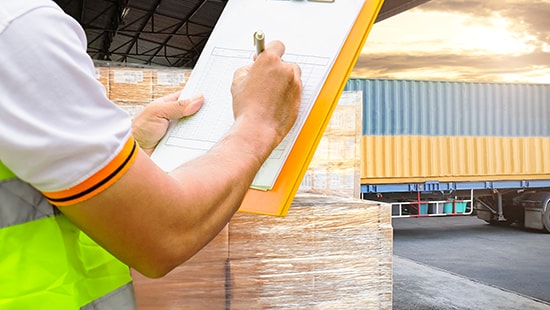Best Practices for Inspection of Incoming Goods
The Pest Monitor Newsletter

STEP 1:
Be prepared for an incoming shipment by having the proper tools on hand. These tools will help when identifying pest activity and aid in the next steps.
- Broom and dust pan
- Flashlight
- Magnifying device
- Pen and paper
- Pest Evidence and Sighting Log
- Pest ID guides (rodent, stored product pest, etc.)
- Phone (taking notes, photos, calling QA, etc.)
- Scraper
- Specimen collection container
STEP 2:
If this is a first shipment from a new supplier or trucking company, open the trailer doors away from the dock. Then do an inspection using sight, smell, and sound looking for signs of activity. An inspection should also be conducted for trusted suppliers, but this can generally be done at the dock.
STEP 3:
If it passes inspection, back the truck into the dock, and begin to gradually unload the pallets:
- Remove the first 8 to 12 feet of pallets –or about 1/3 of the total pallets in the shipment. Place them on the dock and conduct a complete inspection of the pallets, material, and emptied area of the trailer floor.
- If there is no evidence of pests, remove the next third, and conduct the same inspection of these; then remove the final third in the same manner.
STEP 4:
Once the trailer is emptied, sweep the floor and inspect the contents of the swept materials for any evidence of pests.
STEP 5:
If damaged product, odors or pest evidence is detected, at any point in your inspection of a trailer or supplies, stop unloading immediately, pull the trailer away from the dock, and call QA for a ruling on whether to accept or reject the load.
STEP 6:
Bulk rail cars can be more challenging to inspect, but, at a minimum, you should conduct a visual review of the top of the product and, if possible, sift or probe some of the product to check for pest activity.
STEP 7:
If pallets are stacked outside and reused, a visual inspection for pests, signs of pests, or other contaminates before bringing them into the building Additionally, the pallets should either be washed, or if that is not possible, a high pressure air blower can be used to remove outside contaminates.
STEP 8:
Trailers used for storage should undergo this same inspection process as above (See 1-4). Additionally,
- Thoroughly clean and inspect the trailer for holes before using for storage. One way to check for holes is to step inside during the day and close the doors. Any light coming in from the outside signifies a hole.
- During storage on the lot, trailer doors should be kept closed; when opened, they should be managed.
STEP 9:
Partner with your Ecolab Service Specialist if you find any signs of pest activity between service visits. Consistent communication is key to help maintain a pest-free environment.

